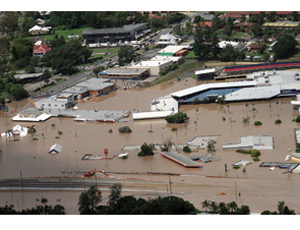Flooding in the state of Queensland, Australia, that began in late December has killed at least 22 people, left thousands homeless, destroyed countless buildings and devastated highways and rail lines. Overall, the flooding has affected 70% of Queensland, an area the size of France and Germany combined.

As of early February, residents were bracing for more coastal flooding, which was expected to accompany Cyclone Yasi, a Category 4 tropical storm that was forecast to hit the northern coast on Feb. 3.
Queensland has experienced heavy rainfall since August, with the almost continuous rain in December resulting in overflowing rivers throughout the state. Areas in the north were declared disaster zones on Dec. 27, with flooding reaching the south by Jan. 10 and the state capital, Brisbane, by Jan. 12.
The full economic impact has yet to be determined, but personal property insurance claims already have exceeded $1.2 billion. The total cost of rebuilding could top $20 billion, according to government reports.
Recovery efforts are beginning to take shape. On Jan. 19, Queensland’s Premier Anna Bligh established the Queensland Recovery Authority, which is charged with overseeing reconstruction and coordinating efforts between federal, state and local governments. The following week, on Jan. 28, the state government announced that it would be awarding nearly $400 million in direct grants to local municipalities; 75% of the grant funding is coming from the federal government’s Natural Disaster Relief and Recovery Arrangements program.
Moreover, a special flood-relief tax may go into effect on July 1 for all Australians earning more than $50,000 per year. Prime Minister Julia Gillard announced the new tax on Jan. 27, although it still requires parliamentary approval. The revenue will go toward rebuilding not only in Queens-land but also flood-damaged areas in New South Wales, Victoria and Tasmania. Flooding has devastated many parts of Australia since late 2010, including the typically drought-plagued state of Western Australia.
There is some question whether investors will be keen to finance rebuilding projects without some certainty that future floods can be prevented. The last major flood in Queensland, which occurred in Brisbane in 1974, resulted in the construction of the Wivenhoe Dam on the Brisbane River, but it did not lead to regulations regarding construction in flood-prone areas.


Post a comment to this article
Report Abusive Comment